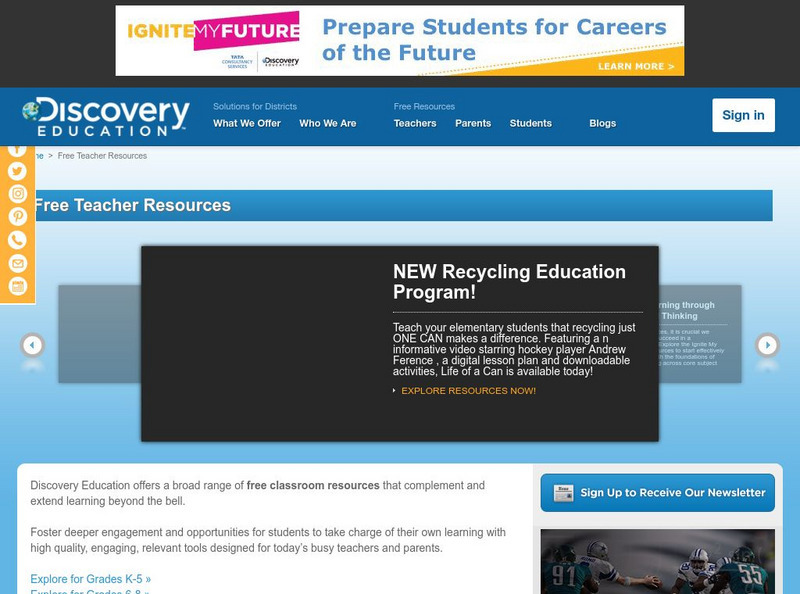Ducksters
Ducksters: Science for Kids: World Biomes and Ecosystems
Kids learn about the world's biomes and ecosystems. The network of life and biodiversity needed for all to survive.
The Environmental Literacy Council
Environmental Literacy Council: Ecosystems
Article explaining ecosystems and why we use them to organize our ideas about the natural world. Links to additional resources, maps, and activities.
ClassFlow
Class Flow: Understanding Ecosystems
[Free Registration/Login Required] This flipchart will help students to learn about ecosystems and the living and nonliving things that interact in them.
ClassFlow
Class Flow: Understanding Ecosystems: Adaptations 3 of 4
[Free Registration/Login Required] Students will understand how animal and plant adaptations help them to survive in their ecosystem. Web links will allow students to play games and learn more about adaptations.
ClassFlow
Class Flow: Understanding Ecosystems: Climate Part 2 of 4
[Free Registration/Login Required] This flipchart will help students understand how climate affects our ecosystems. Links are provided to further their knowledge of the types of plants and animals that live in different climate zones.
ClassFlow
Class Flow: Understanding Ecosystems: Humans Part 4 of 4
[Free Registration/Login Required] Students will be able to understand how humans affect and interact with different ecosystems (such as pollution, habitat restoration). There are opportunities to link to the web to explore this further.
ClassFlow
Class Flow: Understanding Ecosystems: Part 1 of 4
[Free Registration/Login Required] Students will get an introduction to ecosystems. They will be able to distinguish nonliving and living thins in a habitat.
ClassFlow
Class Flow: Where Do They Live?
[Free Registration/Login Required] This flipchart contains an introduction page through which teachers can discuss what all living things need. On subsequent pages students will decide which animal does not belong in the habitat shown.
ClassFlow
Class Flow: Ecosystems
[Free Registration/Login Required] This flipchart explores the different ecosystems of the world, enhanced by embedded videos showing both the landscape and the plants and animals that can be found there.
ClassFlow
Class Flow: Identify the Animal and Its Biome
[Free Registration/Login Required] Each page contains a hidden picture of an animal. Students use a small viewer to expose small pieces of the picture.
ClassFlow
Class Flow: Biomes of the World
[Free Registration/Login Required] This flipchart contains a Life Science lesson for students in grades 7-8. It was specifically designed to assist ESL students read, pronounce, and understand the meanings of key concepts presented in...
ClassFlow
Class Flow: Changes in Habitats
[Free Registration/Login Required] A 2nd grade unit on how people and weather can change habitats. Topics include too much and too litter rain (flooding and drought), lightning and fire, and land, water, and air pollution. This flipchart...
ClassFlow
Class Flow: Ecosystems
[Free Registration/Login Required] This flip chart covers critical thinking skills, discovery, inquiry, comprehension strategies, and analyzing ecosystems. There is vocabulary matching, searching the web for answers, United Streaming...
ClassFlow
Class Flow: Ecosystems and Ecology
[Free Registration/Login Required] This flipchart is a two-part lesson which teaches the students about ecosystems and changes in ecosystems. In addition, it discusses pests, pest control, and how humans change ecosystems in a positive...
ClassFlow
Class Flow: Energy in Ecosystems Habitat
[Free Registration/Login Required] This flipchart discusses the habitats in ecosystems.
Utah Education Network
Uen: Utah's Plants and Animals Do You Know Where I Live?
Can you figure out what types of biomes different organisms belong in? You'll be presented with a variety of organisms and asked which of three biomes they belong in.
Other
Open2.net: Ecosphere
Designed by the Open University and the BBC, this website from Open2.net explores ecosystems. Included is a lengthy discussion on closed ecosystems and their importance to research, as well as a virtual ecosystem, an interactive showcase...
Other
University of Puget Sound: World Biomes
Author provides an explanation of the term Biome and the relationship of climate, soils, vegetation, diversity, adaptations, and human effects to the biome.
Annenberg Foundation
Annenberg Learner: Ecology Lab
Build your own ecosystem, and explore the effects of these interrelationships.
ClassFlow
Class Flow: Habitats
[Free Registration/Login Required] Through this unit, children will begin to understand the concept of a habitat, how it provides organisms found there with conditions for life and how animals depend on plants or other animals which eat...
Discovery Education
Discovery Education: Habitats of the World
This site has a lesson to use to start a unit on biomes and animal habitats. This plan incorporates grasslands, temperate forests, tropical rainforests, deserts, polar ice regions, and tidepools.
Discovery Education
Discovery Education: Make It a Habitat
This lesson plan explores the adaptation of life forms through natural selection to fill various niches and accommodate changing environmental conditions.
Science Struck
Science Struck: The 6 Chief Levels of Organization in Ecology
Describes six levels of organization in the biological world - individual species, population, community, ecosystem, biome, and biosphere.
ClassFlow
Class Flow: Ecosystems
[Free Registration/Login Required] A flipchart covering the concepts and ideas required to understand ecosystems, with particular concentration on the tropical rain forest.
























